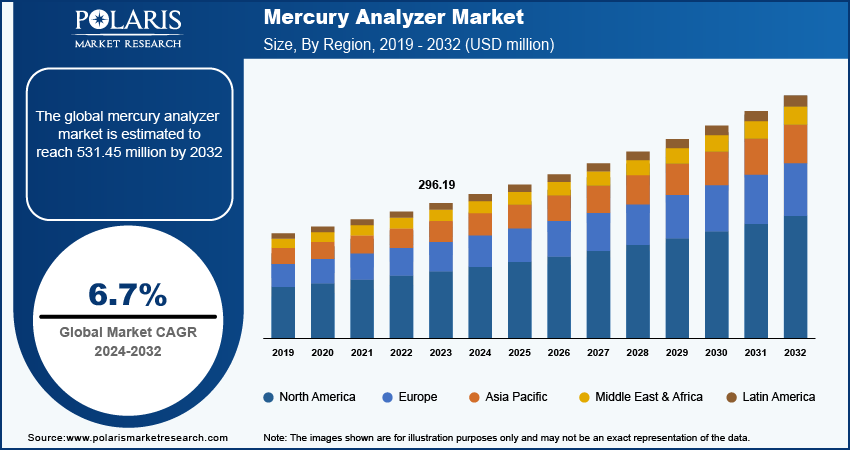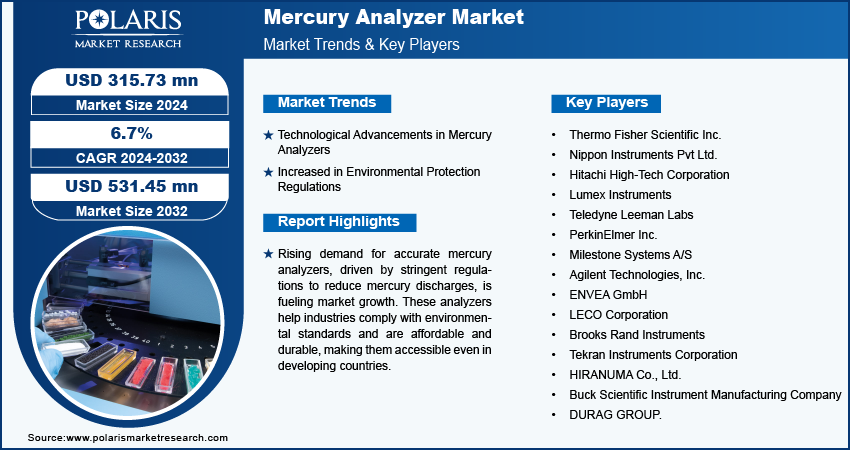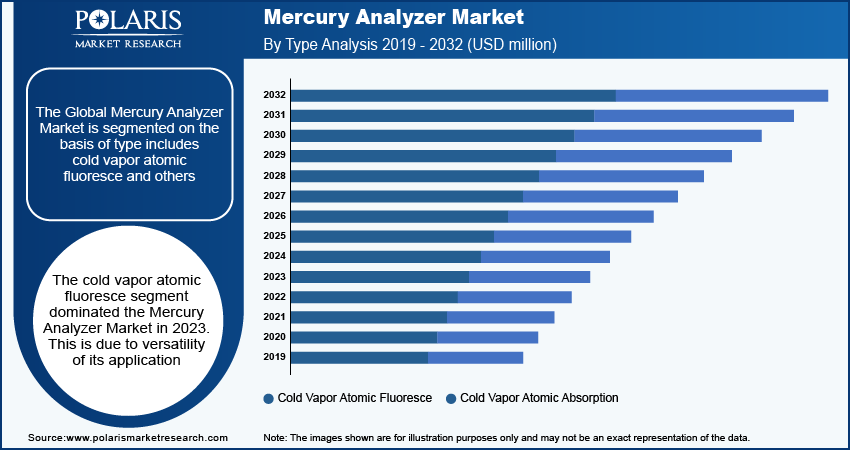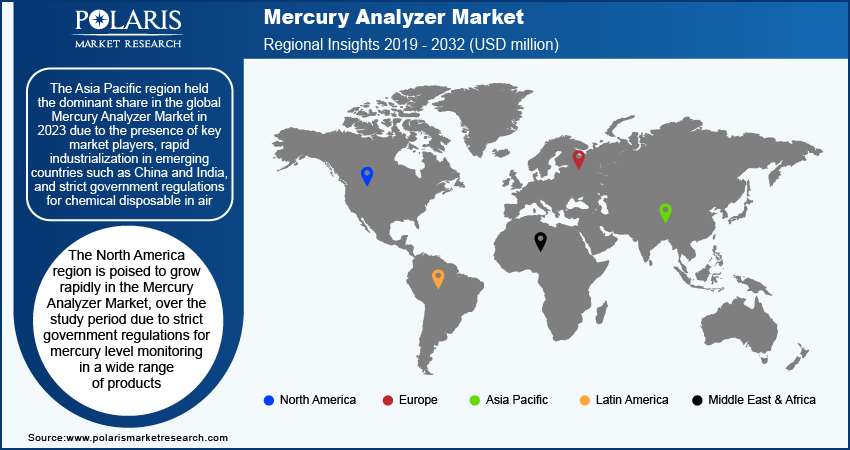
Mercury Analyzer Market Share, Size, Trends, Industry Analysis Report – By Type (Cold Vapor Atomic Fluoresce and Cold Vapor Atomic Absorption), End-Use Industry, Sales Channel, and Region; Segment Forecast, 2024–2032
- Published Date:Oct-2024
- Pages: 117
- Format: PDF
- Report ID: PM5105
- Base Year: 2023
- Historical Data: 2019-2022
The mercury analyzer market size was valued at USD 296.19 million in 2023. The market is anticipated to grow from USD 315.73 million in 2024 to USD 531.45 million by 2032, exhibiting a CAGR of 6.7% during 2024–2032.
Market Overview
The mercury analyzer market is primarily driven by increasing demand for efficient monitoring of mercury levels. Rapid industrialization in emerging countries has increased the hazardous impacts of Mercury on the human population, leading to a rise in demand for mercury analyzers. Moreover, the demand for mercury analyzers is driven by numerous environmental protection regulations imposed by governments worldwide. Environmental conditions are actively monitored by governments and regulatory bodies, leading to a higher demand for mercury analysis to ensure compliance with environmental standards.

To Understand More About this Research:Request a Free Sample Report
The mercury analyzer market is expected to experience significant growth in the coming years due to increasing merger and acquisition activities and strategic partnerships among key players. These collaborative efforts aim to expand product offerings and optimize resource exchanges. Companies are working together to leverage complementary technologies and expertise, enhancing innovation capabilities, improving market reach, and effectively addressing evolving customer needs. These mergers and collaborations simplify operations and accelerate the development of advanced mercury analysis solutions, leading to market expansion.
Growth Drivers
Technological Advancements in Mercury Analyzers
Technological advancements in mercury analyzers enhance the performance and accuracy of the devices. These advancements include improvements in detection sensitivity, analytical precision, and automation, which streamline the measurement process and reduce human error. These capabilities result in lower detection limits and faster response times, allowing for more comprehensive and reliable environmental monitoring, particularly to meet strict regulations. Additionally, advancements in user interface design and data management systems make these analyzers more accessible and efficient for various applications. For instance, in March 2024, Tekran Instruments Corporation unveiled a unified software platform for its Tekran 2600-IVS Total Mercury and Tekran 2700 Methyl Mercury Systems. This integrated solution enhances data management, analysis, and operational efficiency, offering streamlined functionality across both mercury measurement systems. As industries increasingly demand higher precision and efficiency, these technological improvements drive the growth of the mercury analyzer market.
Increased Environmental Protection Regulations
An increase in demand for accurate and dependable mercury analyzers due to strict government policies for minimizing mercury discharges fuels the mercury analyzer market growth. Mercury analyzers are important in assisting industries in complying with environmental regulations as they provide accurate, reliable information on levels of mercury that, in turn, facilitate adjustments before polluting the environment. The affordability, sturdiness, simplicity, and wide availability of total mercury analyzers make them highly suited for monitoring mercury exposure even in developing countries.
Restraining Factors
High Initial Investments in Advanced Technology
The high cost associated with mercury analyzer manufacturing and procurement hinders the mercury analyzer market growth. The market may face obstacles in expanding its reach due to the significant investment needed to purchase and maintain these advanced instruments of mercury analyzers.

Report Segmentation
The mercury analyzer market is primarily segmented on the basis of type, end-use Industry, sales channel, and region.
By Type Analysis
Cold Vapor Atomic Fluoresce Analyzer Segment Accounted for Larger Revenue Share in Mercury Analyzer Market in 2023
The cold vapor atomic fluorescence analyzer segment accounted a larger revenue share in 2023, driven by its superior sensitivity and accuracy in detecting low levels of mercury. This technology allows for real-time monitoring, making it essential for industries and regulatory bodies focused on environmental protection and public health. Additionally, the increasing awareness of mercury's harmful effects has led to greater demand for precise measurement tools. As regulatory frameworks tighten globally, the need for reliable and efficient mercury analysis continues to boost the adoption of cold vapor atomic fluorescence analyzers in various applications.
The cold vapor atomic absorption segment is projected to register a higher CAGR during the forecast period due to its advantages such as high accuracy and sensitivity in mercury detection. Moreover, cold vapor atomic absorption-based instruments have lower costs, ease of operation, and suitability for field applications, which drives the segment’s growth.
By End-Use Industry Analysis
Food Industry Segment to Witness Highest Growth Rate During Forecast Period
The food industry segment is projected to register the highest CAGR in the mercury analyzer market during the forecast period. The market growth for the segment is driven by various advantages of mercury analyzers such as better monitoring and control of mercury levels in food products, which reduces the risk to public health and maintains the brand reputation of food industry players.
The environmental monitoring segment held the largest revenue share of the mercury analyzer market in 2023. The dominance is primarily attributed to regulatory compliance, cost-effectiveness, and increased research and development investments. Moreover, a wide range of applications such as flue gas analyses, land-fill leachate assessments, and air measurements accelerate the segment growth.

Regional Insights
Asia Pacific Held Largest Share of Global Market in 2023
Asia Pacific held the dominant share of the mercury analyzer market in 2023 due to the presence of key market players, rapid industrialization in emerging countries such as China and India, and strict government regulations for chemical disposable in air. Furthermore, the expansion of the oil & gas and petroleum industries accelerates the demand for mercury analyzers in the region.
North America is expected to register the highest CAGR in the mercury analyzer market during the forecast period due to strict government regulations for mercury level monitoring in a wide range of products and increasing investments in research and development for manufacturing mercury analyzers with advanced technology.
In February 2024, Lumex Instruments introduced Light 915M2, the successor to the widely used Light-915 mercury analyzer. To improve industrial mercury monitoring, Light 915M2, the new model using Lumex Zeeman atomic absorption spectrometry (AAS) technology, has incorporated substantial upgrades.

Key Market Players and Competitive Insights
Strategic Partnerships to Drive Competition
The mercury analyzer market is fragmented. The expansion of the product portfolio for the various end-use industries is positively impacting the global mercury analyzer market. In August 2022, Lumex Instruments expanded its portfolio with a comprehensive range of mercury analyzers designed for detecting trace amounts of mercury across various sample types, including solid, liquid, and gas. The new additions include the RA-915M, along with the automated RA-915Lab and RA-915AM versions, tailored specifically for laboratory and outdoor air analysis applications. This expansion enhances Lumex's ability to provide versatile and precise mercury measurement solutions for diverse analytical needs.
Major Players Operating in Global Mercury Analyzer Market
- Thermo Fisher Scientific Inc.
- Nippon Instruments Pvt Ltd.
- Hitachi High-Tech Corporation
- Lumex Instruments
- Teledyne Leeman Labs
- PerkinElmer Inc.
- Milestone Systems A/S
- Agilent Technologies, Inc.
- ENVEA GmbH
- LECO Corporation
- Brooks Rand Instruments
- Tekran Instruments Corporation
- HIRANUMA Co., Ltd.
- Buck Scientific Instrument Manufacturing Company
- DURAG GROUP.
Recent Developments in Industry
- In February 2024, Finlay Minerals announced the successful application of its proprietary RA-915M device for a mercury detection survey in polymetallic deposits located in British Columbia. This achievement was part of the 2023 field operations, which included bio-geochemical sampling and soil mercury (Hg) vapor analysis.
- In February 2023, scientists utilized the Lumex RA-915M analyzer mounted on a UAV to map the three-dimensional spatial dispersion of gaseous elemental mercury (GEM) in the ambient air surrounding former mercury mining sites in Abbadia San Salvatore, Italy.
Mercury Analyzer Market Segmentation
By Type Outlook (USD million, 2019–2032)
- Cold Vapor Atomic Fluoresce
- Cold Vapor Atomic Absorption
By End-Use Industry Outlook (USD million, 2019–2032)
- Oil & Gas
- Petroleum Industry
- Food Industry
- Environmental Monitoring
- Other
By Sales Channel Outlook (USD million, 2019–2032)
- Online Sales
- Offline Sales
By Regional Outlook (USD million, 2019–2032)
- North America
- US
- Canada
- Europe
- Germany
- France
- UK
- Italy
- Spain
- Netherlands
- Russia
- Rest of Europe
- Asia Pacific
- China
- Japan
- India
- Malaysia
- South Korea
- Indonesia
- Australia
- Rest of Asia Pacific
- Middle East & Africa
- Saudi Arabia
- UAE
- Israel
- South Africa
- Rest of Middle East & Africa
- Latin America
- Mexico
- Brazil
- Argentina
- Rest of Latin America
Report Coverage
The mercury analyzer market report emphasizes key regions across the globe to provide a better understanding of the product to the users. Also, the report provides market insights into recent developments and trends and analyzes the technologies that are gaining traction around the globe. Furthermore, it covers an in-depth qualitative analysis pertaining to various paradigm shifts associated with the transformation of these solutions.
The report provides a detailed analysis of the market while focusing on various key aspects such as competitive analysis, type, end-use industry, sales channel, and futuristic growth opportunities.
Mercury Analyzer Market Report Scope
|
Report Attributes |
Details |
|
Market Size Value in 2024 |
USD 315.73 million |
|
Revenue Forecast by 2032 |
USD 531.45 million |
|
CAGR |
6.7% from 2024 to 2032 |
|
Base Year |
2023 |
|
Historical Data |
2019–2022 |
|
Forecast Period |
2024–2032 |
|
Quantitative Units |
Revenue in USD million and CAGR from 2024 to 2032 |
|
Segments Covered |
|
|
Regional Scope |
|
|
Competitive Landscape |
|
|
Report Format |
|
|
Customization |
Report customization as per your requirements with respect to countries, regions, and segmentation. |
FAQ's
The mercury analyzer market size was valued at USD 296.19 million in 2023 and is projected to grow to USD 531.45 million by 2032
The global market is projected to register a CAGR of 6.7% during the forecast period.
Asia Pacific accounted for the largest share of the global market in 2023.
A few key players in the market are Thermo Fisher Scientific Inc., Nippon Instruments (India) Pvt Ltd., Hitachi High-Tech Corporation, Lumex Instruments, Teledyne Leeman Labs, PerkinElmer Inc., Milestone Systems A/S, Agilent Technologies, Inc., ENVEA GmbH, LECO Corporation, Brooks Rand Instruments, Tekran Instruments Corporation, HIRANUMA Co., Ltd., Buck Scientific Instrument Manufacturing Company, DURAG GROUP.
The food industry segment is anticipated to experience substantial growth at a significant CAGR in the global market during the forecast period. This growth is attributed to an increase in demand for mercury monitoring in food products.
The cold vapor atomic fluoresce segment accounted for a larger revenue share of the market in 2023 due versatility of its application.
